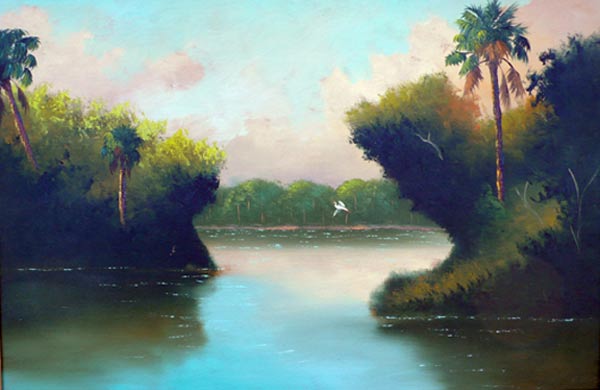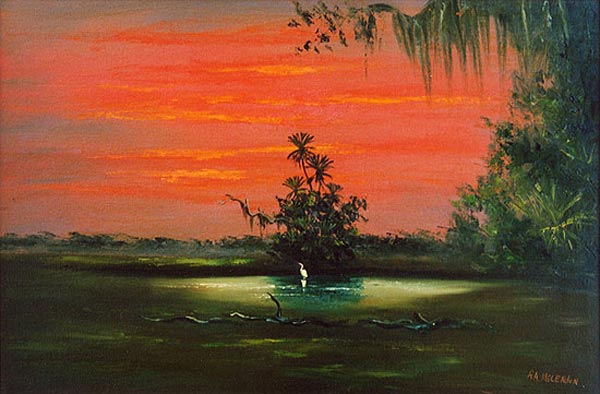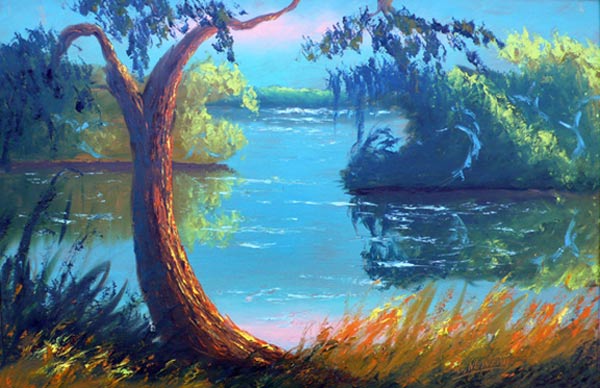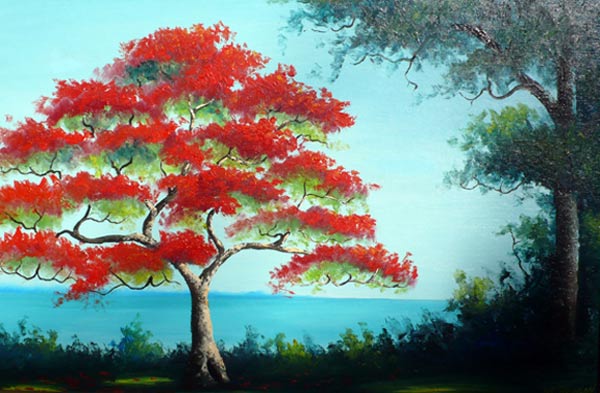The Original Florida Highwaymen Artist Bios
Read about each of the artists and view a sample of their artwork

Curtis Arnett b. 1950
Although one of the younger members of the collective, Curtis Arnett began painting by his teenage years, when he met the regionalist A.E. Backus. He took jobs unrelated to art, including working as a security guard, but his interest in art stayed with him. He was mentored by Hezekiah Baker.

Hezekiah Baker 1940 – 2007
When Hezekiah Baker showed a painting he had recently completed to Alfred Hair, he reported that Hair asked, “How long did it take you to paint that picture?” Hezekiah replied, “About 5 or 6 hours,” to which Alfred commented, “I can show you how to paint a lot of paintings in that amount of time.” Hezekiah then stopped subscribing to the correspondence painting school from which he received instruction, and became instead absorbed into the practice, along with the others. Soon his paintings revealed a style similar to his friends’ paintings. But his wife preferred he had a steady income, so he sold insurance and real estate for a while, until opening his own restaurant, House of Food.

Al Black b. 1945
Business for the artists was so brisk that they often employed salesmen; in turn the sales force stimulated an even greater output of paintings to keep up with the growing demand. Of the many salesmen, Al Black was in a class all his own. He sold to people who had rejected the other salesmen and painters. Signs prohibiting solicitation or those banning Negroes did not intimidate him. Al learned to paint by repairing those paintings that had been left in his care for sale. He did not start creating his own artwork until Alfred Hair’s death in 1970. Until then, he simply could not spare the time to paint. Al was making a lot of money from the sales, taking 30% from each painting he sold for others. Often he would add that much more to the sales price, which he would keep for himself.

Ellis Buckner 1943 – 1991
Motivated by the amounts of money he saw the artists making, Ellis Buckner and his brother George left laborious jobs for art making. They were running a barbeque business in Gifford when they met Livingston Roberts. The brothers visited him and watch him paint beneath a tree in the backyard of the apartment he rented above a social hall. The more they watched Livingston paint, the more enthusiastic they became, and soon, with his encouragement, the brothers began painting. It turned out that Ellis was a good painter but a better salesman, so he was soon selling more than he was painting. He sold both his own and George’s paintings. Blessed with the gift of gab he would often take them on the road while his brother stayed home and painted.

George Buckner 1942 – 2001
George Buckner didn’t like "running the road," so his brother Ellis took the lead when it came to selling their artwork. Like others in Gifford, George was not in a rush; though mentored by Livingston Roberts he didn’t subscribe to fast-painting. He took his time in crafting traditionally beautiful pictures. Impressed by Harold Newton, he kept reference books about classical composition in his studio, and he developed the requisite still to emulate these compositions. When he wasn't painting George was playing his guitar, piano, or saxophone. The brothers, unlike the others who maintained their home bases, set-up elsewhere, in a studio on U.S.1 in Cutler Ridge, just south of Miami, and sold at the outdoor art shows there.

Robert Butler 1943 – 2014
Robert Butler painted the backwoods and backwaters of central and south Florida because he lived inland, in Okeechobee, and therefore away from the action that the other painters were experiencing along the Atlantic coast. Because of the locale and consumers’ tastes, indigenous wildlife was often represented in his paintings. Jim Fitch, who in 1995 dubbed the artists The Highwaymen after conversations with Butler, once said, "Robert sold more turkeys than Publix."

Mary Ann Carroll b. 1940 – 2019
Mary Ann Carroll had to feed, clothe and shelter her seven children; most of the time she was their sole support. She took an array of laborious jobs, but soon after meeting Harold Newton, she concentrated on honing her own painting skills. By the time her marriage failed she was making a living from the sales of her paintings, as were the other core artists. In addition to being a devout woman of faith, a prolific artist and a very busy parent, she had energy to sing in the church choir and build her own ministry. Mary Ann is the sole Highway-woman and was honored by Michelle Obama at the First Lady’s Annual Luncheon in Washington, DC on, May 18, 2011.

Johnny Daniels 1954 – 2009
Johnny Daniels was the youngest of the Highwaymen. As the kid brother to Willie Daniels, he used to sit on the sidelines assembling the carpenter trim that was used to construct frames for the artists’ paintings. For this he earned a pittance of the amount of money that he saw the artists reap for their works. He also saw how much fun they had during their social painting sessions. It was then that Johnny decided to become an artist and entrepreneur.

Willie Daniels b. 1950 – 2020
Willie Daniels lived with his family in a house next to Harold Newton’s and Roy McLendon’s houses. He acknowledges their influence on his own artistic development. Indeed, with a formal resolve and the idiosyncratic nature of their styles, Willie’s paintings epitomize the Highwaymen ideal. More often than the others, he employed Al Black to sell his paintings. Often Willie left his works unsigned; Black would sign them, with his own name, to facilitate sales. Hence, some paintings signed A. Black are really Willie Daniels’ creations.

Rodney Demps b. 1953 – 2020
Rodney Demps absorbed Alfred Hair’s painterly concerns by, he says, going to Alfred’s house when he was needed to prep Hair’s boards. “I watched him bring them to life,” he said. Rodney’s own paintings offered an extreme in Highwaymen art. They were markedly surreal in comparison to those by the others. A critic might say that his sunset colors weren’t accurate; maybe they were not, but they were likely excellent metaphors for a South Florida summer sunset, no matter how ephemeral. Perhaps such a critic never really saw a Florida sunset, with its unbelievable hues.

James Gibson b. 1938 – 2017
James Gibson was, and still is, the careerist among the cohort. He’s made remarkable strides since the Highwaymen’s renaissance. He was central to the group dynamic when it formed but also, unlike the others, nurtured his own professional future. His artwork stood apart, too. He did not practice their painterly style; he did not use unrestrained long brush strokes. Rather, James’s paintings were made with flatter colors depicting simple scenes. However, they were distinguished; his use of Kool-Aid colors accounted for striking scenes that captured, in their own way, the Florida experience. And this is essential – although Highwaymen paintings were sometimes referred to with the dismissive referent, “motel art,” James’s paintings prove that this label was, unbeknownst to such critics, a compliment. What idea better captured the times, conjuring mental pictures of Florida then?

Alfred Hair 1941 – 1970
Alfred Hair was not, in any way, out to form a school of art or an art movement but that is what happened. He simply wanted an alternative to the menial labor that seemed to be likely source of income for young African Americans growing up in the shadow of Jim Crow. Having big dreams, he was well prepared for leadership. He had studied painting during his high school years from the esteemed regionalist A.E. Backus, thereby making him the only Highwayman painter to have had formal art lessons. Through his spirit of generosity, together with his charisma and artistic abilities, Alfred was a natural leader. It was through him that others realized there was a way to beat the odds – by painting Florida landscapes. Through fast-painting, he and those he influenced arrived at a fresher aesthetic of landscape interpretation than had been the norm. Furthermore, Alfred showed the other painters how to market these images along the state’s eastern seaboard. In fact, he was so successful in this enterprise that he needed to enlist salesmen, to whom he sometimes furnished cars. Alfred gave this group a semblance of form, but for these then-unnamed artists, there were no rules or dues, just great opportunities and a zest for life.

Issac Knight b. 1941 – 2022
As his wife Lillie points out, “Ike became a Highwaymen and painter almost inadvertently.” He initially got his start by being a seller of Alfred Hair’s and Al Black's paintings. Al, who is his brother-in-law, mentored him and Issac painted when he wasn’t at work at Northrop Grumman Aerospace. He recalls that his early "un-perfected paintings," were the first ones to sell. The fast-paintings of Hair, Black and others in their Ft. Pierce community practice yielded a sketchiness that compelled viewers to imagine the places described. Issac may have, in time, perfected his technique but he never lost the distinguishing characteristics of Highwaymen art.

Robert Lewis b. 1941
Being a public school art teacher in the Cocoa region, left Robert Lewis out of the painting scene that was happening further south. He began painting in the style of the itinerant artists. He and Sylvester Wells were among the most peripheral of the loose affiliation of these painters. Having earned his college degree in design, Robert relied on this training and the inspiration of Harold Newton’s paintings to inform his own. He remains an affable artist, an able art instructor and capable merchandiser of his paintings.

John Maynor 1948 – 2016
John Maynor was a premier sign painter, highlighting businesses along Avenue D and many other stores in Ft. Pierce. He was a friend of some of the community’s artists and began painting landscapes in their manner. Livingston Roberts commented, when Maynor’s name came up late in the identifying of the cohort, that “he’s more of a Highwaymen than some of the others on your list.”

Roy McLendon b. 1932 – 2024
Roy McLendon's paintings combine the best of Alfred Hair's fast-painting with Harold Newton's controlled finesse. Other Highwaymen had dabbled in the arts during their youth, but Roy painted with artistic intent prior to meeting Alfred. He was establishing a clientele when Alfred began his enterprise. The two men were the best of friends, but their ideas differed. Roy was more in tune with Harold's approach to painting than those working fast and furiously in Ft. Pierce. Roy's distinguishing brush-strokes yield a shimmering quality, making them well-suited for capturing Florida light. Although the vast majority of Highwaymen paintings are devoid of worldly concerns, and are even without the presence of animals, Roy sometimes placed people in the scenes he painted with more frequency than anybody else in the cohort.

Alfonso Moran 1930 – 2003
Alphonso Moran was severely disabled by a stroke in his final years, when interest in the Highwaymen sparked anew, and was unable to communicate. During his youth he worked as a barber and freelanced as a house painter. He socialized with Alfred Hair and painted landscapes at his Gifford home, while playing poker and shooting pool regularly. A skilled gambler, he gravitated away from creating art to become a pool shark.

Harold Newton 1934 –1994
Harold Newton set the stage for the group of aspiring artists that would decades later become known as the Highwaymen. As soon as he returned to his family home in Gifford, the African-American community adjacent to Vero Beach, in the late 1950s Harold embarked on a career of a professional artist. With innate talent his success was immediate and as certain as his formidable skill. He painted at home and traversed the region selling his oil paintings. When he wasn’t painting, he was likely fishing. Nevertheless, it was his model that Alfred Hair would adopt but engage at warp speed to create an art phenomenon.

Lemuel Newton b. 1950 – 2015
Lemuel Newton, one of the three Newton brothers who became artists, came to Gifford along with his brother Sam to learn the craft from their older brother Harold. Lemuel learned the requisite skills, but he was waylaid by personal problems that led him astray from realizing his artistic potential.

Sam Newton b. 1948
Sam Newton did indeed rise to the occasion, and became a successful landscapist by working in his brother Harold’s manner. He, more than others, heralded the difference in influence that emanated from his brother’s model and even shunned that of the Ft. Pierce contingency, which was, and is, identified by Alfred Hair’s modus operandi. Sam contentiously said that he and his brothers were not Highwaymen and that their attitudes were of another ilk. He may have been claiming that it was Harold who captivated others with his magical skill and that Harold’s attitude and artwork inspired Alfred and awed the others.

Livingston Roberts 1942 – 2004
Livingston Roberts was there at the start, when, in 1961, Alfred Hair graduated from high school and embarked on his remarkable journey. Hair and Harold Newton established the parameters and Roberts, along with Roy McLendon and James Gibson, were the first to join ranks. Although it is true that the success of Highwaymen art depended on a stripped-bare aesthetic, Livingston made unembellished paintings with the most regularity. He painted without much fanfare to arrive at the basic Highwaymen representations of the landscape. Because of their lack of ornamental pretense, his paintings may be said to be the visual model of the shared Highwaymen aesthetic.

Willie Reagan b. 1939
Willie Reagan returned home in 1966 to Gifford after graduating from FAMU and completing military service. He sought out the Buckner brothers and Alphonso Moran for insight into the painting scene that was well underway there. He found employment with the school board, and was an art teacher for 28 years. Willie met Alfred Hair and Mary Ann Carroll but really didn’t know the Ft. Pierce contingency. He preferred a sedate home life to fast living so he naturally gravitated to the finessed paintings that identified the Gifford artists rather than the sketchier fast painting being created down the road in Ft. Pierce. He preferred to sell his own paintings than engage commissioned salesmen too, explaining, “I was the best salesman of my own paintings,” and unlike others, he proudly held firm to his prices.

Carnell Smith b. 1950 – 2015
Carnell Smith was Alfred Hair’s brother-in-law, and Alfred and his wife Doretha took him in during troubled times; he was often getting in trouble. “Alfred got me out of the streets,” he says. Alfred also got Carnell into the studio that he had built in the back of their Dunbar Street home. Carnell then joined Doretha in “doing the background work.” He recalls Alfred instructing them, “Doretha, you do moonlight. Pete [Carnell’s nickname], you do sunsets.” Once the multiple boards were prepared, Alfred would come by to enliven each one as he free-flowingly painted, establishing each painting’s meaning. Carnell began making frames for Alfred’s paintings in 1965, when he moved into the Hair’s new home-studio, and began generating his own paintings in 1967. He later moved to Philadelphia to study theology and became a senior pastor at the Gate to Heaven Ministry there.

Charles Walker b. 1945 – 2022
Charles Walker was well prepared to be an artist. As a teenager he accompanied his father when he went hunting. His father jokingly complained that his son was “bad luck,” because Charles would always pray for the animal in his father’s sight. Charles preferred to draw animals, rather than shoot them. He married his high school sweetheart, Gertrude, who is Livingston Robert’s sister; this put him one step closer to fulfill his creative ambitions. Gertrude encouraged him to paint as she was doing, and he did; Charles began to paint and sell in 1968. From the start his paintings always included wildlife, which made them meaningfully different from the cohort's paintings. He honed his technique so the paintings became increasingly controlled and detailed; this made it all the better for him to depict the animals, fish and birds he loves to paint.

Sylvester Wells b. 1937 – 2023
Sylvester Wells lived in Cocoa, and this suited him fine. Devoutly religious, other than meeting Alfred Hair and watching Harold Newton paint, he didn’t associate with the other artists. He and his wife Clezell have lived in Tennessee, so he was and remains distant to Highwaymen activity. Since his vision began to fail, Clezell has helped him make his paintings. S.M., as he’s called, is a passionate preacher, and he uses any and every opportunity to share the gospel.

Charles Wheeler b. 1946 – 2019
Charles Wheeler shuns attention, and was the last Highwaymen to be recognized when the original research was complied. Then he lived in a small nondescript house while working as a fruit picker. He was also among the last to pick up a brush after the long dormancy and return to finding income through painting.
† deceased
Help Us Build a Highwaymen Museum!

